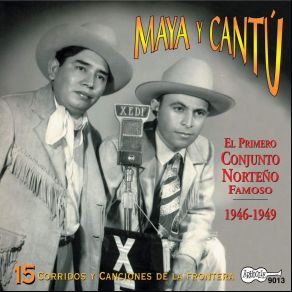El Primero Conjunto Norteño Famoso 1946-1949 / El Primero Conjunto Norteno Famoso 1946-1949
Download links and information about El Primero Conjunto Norteño Famoso 1946-1949 / El Primero Conjunto Norteno Famoso 1946-1949 by Maya, Cantu. This album was released in 1999 and it belongs to Latin genres. It contains 15 tracks with total duration of 43:38 minutes.

|
|
|---|---|
| Artist: | Maya, Cantu |
| Release date: | 1999 |
| Genre: | Latin |
| Tracks: | 15 |
| Duration: | 43:38 |
| Buy it NOW at: | |
| Buy on iTunes $9.99 | |
Tracks
[Edit]| No. | Title | Length |
|---|---|---|
| 1. | Arnulfo Gonzalez | 3:12 |
| 2. | Tengo un Amor | 2:42 |
| 3. | La Cantinera | 2:40 |
| 4. | Aquí Te Quedas | 3:04 |
| 5. | Dionicio Maldonado | 3:19 |
| 6. | La Barranca | 2:29 |
| 7. | Pedro Nevarez | 3:03 |
| 8. | El Mojado | 3:21 |
| 9. | Los Tequileros | 2:54 |
| 10. | Cual de los Dos Amantes | 2:40 |
| 11. | Ya Tengo Otro Amor | 2:45 |
| 12. | Soy Errante | 2:47 |
| 13. | Jacinto Trevíno | 3:20 |
| 14. | La Voz de Mi Madre | 2:41 |
| 15. | Mira Luisa | 2:41 |
Details
[Edit]This collection of '40s recordings is one of the essential items of historic norteño music, and not just because that style is misprinted as "nortneo" in huge typeface on the back page of the CD booklet. Jesus Maya and Timoteo Cantu, at least for a run of a few years before they got too "boracho" and started squabbling with each other, achieved one of the great duet blends both of vocals and instruments. In the former department the songs here may appeal mostly to those who like to hear Spanish singing, but when it comes to the sound of the bajo sexto and accordion the appeal could very well be universal. This is the kind of instrumental combination which could be the "desert island" choice of a castaway given an opportunity to have one type of combo keep them company while stranded. The bajo sexto is like a more stable 12-string guitar, deeper and capable of a resonant low end that gets a dollop of guacamole slapped on it each time the unidentified bassist keeps his timing together, which is most of the time. Cantu was a player who really helped establish the possibilities of the accordion in Mexican music, effortlessly filling in required roles as a timekeeper and the baker of improvised melodic filigree to go on top, as fluffy and crumbly as Mexican pastry. Listeners who think this is a genre of music played by staggering drunks in cantinas should check out the tempo of a corrido such as "Mira Luisa." Ay, caramba — it moves like a pony doing sprints around a pasture. A superb remastering job has been done on these recordings, which originated as vintage radio broadcast transcriptions.